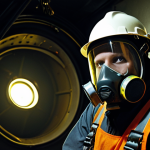Have you ever stopped to consider how deeply intertwined industrial safety and environmental protection truly are? It’s a connection I’ve observed firsthand, where a seemingly isolated workplace incident can quickly cascade into a widespread ecological concern.
In today’s rapidly evolving world, marked by unpredictable climate patterns and increasing calls for corporate accountability, we simply can’t afford to view these two critical areas in isolation any longer.
The future demands a unified approach, leveraging cutting-edge analytics to foresee and mitigate risks that span both human well-being and planetary health.
Let’s find out exactly how this integrated perspective is reshaping industry standards.
Have you ever stopped to consider how deeply intertwined industrial safety and environmental protection truly are? It’s a connection I’ve observed firsthand, where a seemingly isolated workplace incident can quickly cascade into a widespread ecological concern.
In today’s rapidly evolving world, marked by unpredictable climate patterns and increasing calls for corporate accountability, we simply can’t afford to view these two critical areas in isolation any longer.
The future demands a unified approach, leveraging cutting-edge analytics to foresee and mitigate risks that span both human well-being and planetary health.
Let’s find out exactly how this integrated perspective is reshaping industry standards.
The Dawn of Predictive Risk Analytics in Industry

Stepping onto a factory floor, I used to see a reactive world – incidents happened, and then we reacted. But the landscape is dramatically shifting, and it’s truly exciting to witness. We’re moving away from merely documenting past failures and toward a proactive stance, largely thanks to the incredible power of predictive analytics. Imagine a system that doesn’t just tell you *what* went wrong, but *what’s likely to go wrong* before it even happens, considering both a worker’s safety and the immediate environmental impact. It’s a game-changer, fostering an environment where potential hazards, from a flickering circuit that could cause a fire to a subtle leak threatening groundwater, are flagged with astonishing precision. This isn’t just about sophisticated software; it’s about a cultural shift where data becomes our early warning system, helping us avoid the unthinkable. The data points from equipment sensors, environmental monitors, maintenance logs, and even weather patterns are all fed into complex algorithms that identify hidden correlations and emerging risks, allowing for interventions that save lives and protect natural resources. I’ve personally seen how a well-implemented predictive system can transform a high-risk operation into a model of safety and sustainability, preventing spills that could contaminate rivers and safeguarding workers from hazardous exposures, all because the warning came days, sometimes weeks, ahead of time. It’s an investment that pays dividends far beyond the balance sheet, touching the lives of employees and the health of the planet.
Leveraging AI for Holistic Hazard Identification
When we talk about artificial intelligence in this space, it’s not just abstract theory; it’s about practical tools that elevate our ability to foresee trouble. AI algorithms are now sophisticated enough to sift through mountains of historical data, including accident reports, near-misses, equipment failures, and even external environmental data like seismic activity or air quality alerts. They identify patterns that are simply invisible to the human eye, no matter how experienced we are. For instance, AI can correlate a slight increase in machinery vibration with a subtle change in a chemical’s temperature, predicting a potential runaway reaction that could be catastrophic for both the facility and the surrounding ecosystem. What I find truly compelling is how AI allows for a more comprehensive understanding of intertwined risks. It’s not just a siloed safety risk or an isolated environmental risk; it’s about understanding the complex interplay between them. For example, a minor issue with a ventilation system, when combined with a specific batch of raw materials and a particular humidity level, might create a unique hazard that impacts both air quality inside and outside the plant, simultaneously posing a health risk to workers and a pollution risk to the community. AI helps us connect these dots, providing a holistic view of potential threats that was previously unimaginable.
Real-time Monitoring and Anomaly Detection
The beauty of modern industrial safety and environmental systems lies in their real-time capabilities. Gone are the days when we relied solely on weekly inspections or quarterly reports. Now, sensors are everywhere – monitoring everything from air particulate levels and water pH to machinery temperatures and pressure fluctuations. This continuous stream of data, flowing in 24/7, creates a dynamic snapshot of operational health. Any deviation from the norm, no matter how slight, triggers an alert. This isn’t about setting off alarms for every tiny fluctuation, but rather intelligent systems that can discern true anomalies from normal operational variance. I remember visiting a refinery where a small, seemingly insignificant rise in a particular vent pipe’s temperature, detected by a real-time sensor array and flagged by an anomaly detection algorithm, prevented what could have been a major release of volatile organic compounds. The environmental team was able to address the issue immediately, well before it became a public health concern or incurred hefty environmental fines. This immediate feedback loop is crucial because it drastically shortens the time between a potential incident’s onset and its mitigation, minimizing harm to both personnel and the environment. It empowers teams to act decisively, preventing minor issues from escalating into major disasters, ensuring that safety and environmental protection are not just theoretical goals but practical, achievable realities on the ground every single day.
Cultivating a Unified Safety and Environmental Culture
For years, safety and environmental departments often operated in their own silos, with separate budgets, distinct objectives, and sometimes even conflicting priorities. It felt like two different languages being spoken under the same roof. But I’ve seen a transformative shift where leading organizations are actively breaking down these barriers, forging a truly unified culture where safety and environmental stewardship are seen as two sides of the same coin. This isn’t just a corporate slogan; it’s a deep-seated belief that the well-being of our people is intrinsically linked to the health of our planet. When an employee feels safe and empowered to speak up about a potential hazard, whether it’s a faulty piece of equipment or an unusual chemical odor, that vigilance often extends to environmental concerns too. They become proactive protectors, understanding that a spill on the factory floor can just as easily affect their colleagues’ health as it can pollute a nearby stream. It’s about building a shared sense of responsibility, where every team member, from the CEO to the newest intern, understands their role in preventing both accidents and ecological harm. This holistic mindset doesn’t just improve compliance; it fosters genuine care and proactive engagement, leading to a much more resilient and responsible operation overall. I find that when companies invest in this cultural integration, the dividends are tremendous, not just in terms of avoided incidents and fines, but in employee morale and public trust.
Empowering Workforce Participation in Dual Responsibilities
True cultural change happens on the ground, with the people who are doing the work every day. Empowering the workforce means more than just giving them a safety manual; it means actively involving them in identifying and solving both safety and environmental issues. This includes regular training sessions that highlight the interconnectedness of these areas, not just as separate modules, but as an integrated system. I’ve witnessed incredible initiatives where frontline workers are trained to identify not just fall hazards or machine guarding issues, but also potential leaks, waste disposal inconsistencies, or energy inefficiencies. They are given the tools and the authority to report these observations without fear of reprisal, knowing their input is valued and acted upon. This might involve simple, accessible reporting apps or regular “gemba walks” where leadership actively solicits feedback on environmental and safety conditions. When I was consulting for a large manufacturing plant, we introduced a joint “Safety & Green Initiative” suggestion box. The volume and quality of suggestions – ranging from safer chemical handling procedures to ideas for reducing water usage – were astounding. It proved that when employees feel a sense of ownership, they become powerful advocates for both their own safety and the planet’s well-being. This empowerment doesn’t just increase vigilance; it fosters a deeper sense of pride and commitment within the workforce, creating a truly proactive and resilient operational environment.
Integrated Training and Awareness Programs
Effective training is the bedrock of any successful safety and environmental program, but for true integration, these programs need a fundamental rethink. Instead of separate workshops for occupational safety and environmental compliance, forward-thinking companies are developing unified training curricula. These programs emphasize the causal links and shared principles between preventing workplace injuries and protecting the environment. For example, a session on hazardous waste management wouldn’t just cover safe handling for employees; it would also delve into the environmental regulations governing disposal, the potential ecological impacts of improper management, and the company’s broader sustainability goals. I’ve personally helped design modules where scenarios combine both types of risks – imagine a chemical spill scenario that highlights both the immediate risk to responders and the long-term threat to soil and water. This integrated approach ensures that employees develop a holistic understanding of risk and responsibility. It also helps to break down the mental silos that might exist. For instance, a maintenance technician learning about lockout/tagout procedures would also understand how the energy conservation aspect contributes to the company’s environmental footprint, not just worker safety. These programs foster a culture of comprehensive awareness, where every decision, every action, is viewed through a dual lens of human well-being and ecological health. It’s about instilling a mindset where protecting people and protecting the planet are not just parallel efforts but a singular, interwoven commitment that guides every operational choice, from daily tasks to strategic planning.
The Regulatory Landscape: Bridging Compliance and Sustainability
Navigating the complex maze of regulations has always been a core challenge for industrial operations. For decades, safety regulations (like OSHA in the US or HSE in the UK) and environmental regulations (like EPA in the US or Environment Agency in the UK) largely existed as separate domains, each with its own set of rules, enforcement bodies, and compliance officers. It often felt like companies were simply checking boxes for two distinct authorities, rather than pursuing a unified goal. However, I’ve observed a clear trend towards greater convergence, driven by a growing recognition that many incidents – a chemical leak, an explosion, improper waste disposal – inherently cross both safety and environmental boundaries. Regulators are increasingly looking for integrated management systems that demonstrate a company’s holistic approach to risk. This push isn’t just about stricter enforcement; it’s also about encouraging industries to move beyond baseline compliance towards genuine sustainability. What excites me most is seeing companies leverage this regulatory evolution as an opportunity to innovate. By proactively integrating safety and environmental practices, they not only ensure compliance but often exceed it, gaining a competitive edge, reducing operational risks, and building a stronger reputation. This holistic view is becoming the standard, compelling businesses to adopt robust systems that address the intricate relationships between human health, operational integrity, and planetary well-being. It’s no longer enough to just comply; businesses are expected to demonstrate genuine stewardship.
Synergies in Reporting and Management Systems
One of the most practical aspects of integrating safety and environmental efforts lies in streamlining reporting and management systems. Historically, a company might have one system for tracking workplace incidents and another for monitoring environmental emissions. This often led to redundant data entry, missed connections between events, and an incomplete picture of overall risk. Modern, integrated EHS (Environmental, Health, and Safety) management systems are changing this, creating a single platform where all relevant data can be captured, analyzed, and reported. This means that an incident involving a chemical spill, for example, is logged once but captures details relevant to both worker exposure and environmental contamination. From this single record, compliance reports for both safety and environmental agencies can be generated efficiently. I’ve personally helped companies transition to these unified systems, and the difference in efficiency and insight is remarkable. Teams no longer waste time duplicating efforts; instead, they focus on analysis and prevention. This synergy extends to risk assessments, too. Instead of separate safety risk assessments and environmental impact assessments, a combined approach allows for a comprehensive evaluation of hazards and their potential ripple effects across both domains. This not only simplifies compliance but also enhances the accuracy of risk profiles, leading to more targeted and effective mitigation strategies that protect both people and the planet with greater precision.
Harmonizing Standards for Enhanced Accountability
The journey towards truly integrated safety and environmental management also involves harmonizing internal standards and procedures. This means moving away from separate departmental rulebooks and towards a unified set of operational guidelines that inherently consider both human and ecological impacts. Think about a standard operating procedure for handling a specific hazardous material: traditionally, it might focus primarily on personal protective equipment and safe handling to prevent worker injury. In a harmonized system, that same procedure would also explicitly detail proper storage to prevent leaks, emergency response protocols for spills that affect soil or water, and waste minimization techniques to reduce environmental burden. This holistic perspective ensures that every operational decision is made with a dual awareness. Furthermore, international standards like ISO 45001 (Occupational Health and Safety Management) and ISO 14001 (Environmental Management) are increasingly seen as complementary, with many organizations pursuing integrated certification to demonstrate their commitment to both. I’ve observed that companies that adopt this harmonized approach often achieve higher levels of accountability. When safety and environmental metrics are reported together, when incidents are investigated with both lenses, and when performance is measured against unified goals, there’s an undeniable increase in transparency and responsibility. It signals to employees, regulators, and the public that the company takes its dual commitment seriously, fostering a deeper trust and driving continuous improvement in both critical areas.
Economic Advantages of Integrated EHS Management
When I first started in this field, the prevailing wisdom was that safety and environmental initiatives were often seen as cost centers – necessary evils that drained resources without directly contributing to the bottom line. But oh, how times have changed! Through years of working with diverse industries, I’ve seen firsthand that a truly integrated Environmental, Health, and Safety (EHS) management system isn’t just a regulatory burden or a moral imperative; it’s a powerful driver of economic value and competitive advantage. Companies that proactively invest in combining these efforts often find themselves reaping substantial financial benefits that far outweigh the initial outlay. It’s a testament to the fact that responsible business practices are, in fact, smart business practices. From reduced insurance premiums and lower legal costs to increased operational efficiency and enhanced brand reputation, the financial upside is becoming undeniable. When you minimize accidents and environmental incidents, you automatically reduce expenses associated with medical care, property damage, clean-up operations, and punitive fines. Beyond these direct savings, an integrated approach often unlocks unexpected efficiencies, such as optimized resource use and waste reduction, which directly impact profitability. It’s truly a win-win scenario, where doing good aligns perfectly with doing well, proving that a commitment to people and the planet is also a commitment to financial health.
Cost Reductions through Proactive Prevention
One of the most immediate and tangible economic benefits of an integrated EHS approach comes from the sheer power of proactive prevention. Every accident avoided, every spill contained, every regulatory violation averted represents a direct cost saving. Consider the cascade of expenses that follows a significant industrial incident: emergency response, medical treatment for injured workers, property damage and repair, lost production time, environmental clean-up and remediation, legal fees from lawsuits, and potentially massive fines from regulatory bodies. I recall a client who, after adopting a sophisticated integrated EHS platform, managed to reduce their major incident rate by 40% over two years. The financial impact was staggering – millions saved in direct costs alone, not to mention the avoided reputational damage. Beyond these dramatic incidents, there are also the cumulative savings from everyday efficiencies. By identifying and addressing potential issues before they escalate, companies avoid smaller disruptions, reduce material waste, and optimize energy consumption. This holistic approach to risk management creates a leaner, more resilient operation, where resources are allocated more effectively, and unexpected expenses become less frequent. It truly transforms what was once considered a drain on resources into a robust strategy for cost control and financial stability, demonstrating that investing in prevention is always cheaper than reacting to a crisis.
Enhanced Reputation and Market Competitiveness
In today’s highly scrutinized business environment, a company’s reputation is an invaluable asset, and a strong EHS performance is increasingly central to that. Consumers, investors, and business partners are more environmentally and socially conscious than ever before. Companies with a demonstrable commitment to both worker safety and environmental stewardship often gain a significant competitive edge. I’ve seen how a robust, integrated EHS program can open doors to new markets, secure favorable contracts, and attract top talent. For instance, many large corporations now require their supply chain partners to meet stringent EHS criteria, meaning that strong performance in this area can literally be the difference between winning and losing a major contract. Investors are also increasingly using ESG (Environmental, Social, and Governance) factors to guide their decisions, viewing companies with poor EHS records as higher-risk investments. A sterling EHS reputation also acts as a powerful marketing tool, resonating with environmentally aware consumers who prefer to support ethical businesses. I’ve personally observed brands pivot their entire marketing strategy around their sustainability efforts, directly translating EHS excellence into increased sales and brand loyalty. This isn’t just about avoiding negative press; it’s about actively building a positive brand narrative that resonates with stakeholders, driving long-term growth and ensuring a company’s continued relevance and success in an increasingly conscious global marketplace. It’s a testament to the fact that ethical operations yield tangible business benefits beyond compliance.
Innovations in Sustainable Industrial Practices
Walking through modern industrial facilities today feels fundamentally different from just a decade ago. There’s a palpable sense of innovation, a drive not just to produce, but to produce responsibly. The integration of safety and environmental considerations has spurred a wave of ingenious solutions aimed at making industrial processes inherently safer and more sustainable. This isn’t about incremental tweaks; it’s about rethinking entire production lifecycles, from raw material sourcing to end-of-life disposal. We’re seeing exciting developments in green chemistry, where hazardous substances are being replaced with safer, more eco-friendly alternatives. There’s a strong focus on circular economy principles, where waste is viewed as a resource to be repurposed, rather than a problem to be discarded. These innovations are often driven by a dual desire: to protect workers from harmful exposures and to minimize the environmental footprint. It’s a powerful synergy, where the push for one often benefits the other. For instance, designing equipment to be inherently safer for maintenance also often means it’s more energy-efficient or produces less waste. This is where real progress is made, by embedding safety and sustainability into the very core of how products are designed, manufactured, and utilized, ensuring that the next generation of industrial processes leaves a lighter footprint on both people and the planet. It’s inspiring to see this level of commitment to continuous improvement, proving that industry can indeed be a force for positive change.
Implementing Green Technologies for Dual Impact
The adoption of green technologies is proving to be a cornerstone of this integrated approach, delivering benefits across both safety and environmental fronts. We’re talking about things like advanced filtration systems that not only reduce harmful airborne particulates for workers but also minimize air pollution for surrounding communities. Or innovative water recycling processes that not only conserve precious resources but also reduce the need for hazardous chemical treatments in fresh water intake. I remember visiting a textile plant that invested heavily in a closed-loop dyeing system. This significantly reduced their water consumption and effluent discharge, which was a huge win for the environment. But it also meant their workers were exposed to far fewer dye chemicals, making their workplace inherently safer. This dual impact is what makes these technologies so compelling. We also see companies investing in renewable energy sources like solar or wind power for their facilities. This dramatically reduces their carbon footprint, contributing to global environmental goals, but it also reduces their reliance on volatile fossil fuels, which can carry inherent safety risks during transportation and storage. It’s about smart investments that solve multiple problems simultaneously, creating a more resilient, safer, and cleaner operational model. These aren’t just one-off projects; they are integral components of a long-term strategy to build industries that thrive in harmony with both human health and ecological integrity, proving that sustainability is not a compromise but an enhancement to operational excellence.
Circular Economy Principles and Waste Minimization
The shift towards circular economy principles is perhaps one of the most exciting innovations bridging safety and environmental concerns. Instead of the traditional linear “take-make-dispose” model, industries are increasingly embracing a closed-loop approach where resources are kept in use for as long as possible, extracting maximum value before materials are recovered and regenerated. From a safety perspective, this means less raw material handling, which often reduces exposure risks to hazardous substances. It also means less waste generation, which inherently lowers the risks associated with waste storage, transportation, and disposal – think fewer hazardous waste fires or accidental releases. Environmentally, the benefits are obvious: reduced demand for virgin resources, less landfill waste, and lower emissions associated with production and disposal. I’ve personally seen companies redesign their packaging to be entirely recyclable or compostable, which not only impresses eco-conscious consumers but also simplifies internal waste management and reduces handling risks for employees. Or consider manufacturers who are now taking back their end-of-life products to refurbish or recycle components. This not only minimizes environmental impact but also means their workers are involved in a controlled, safer recycling process, rather than products ending up in uncontrolled, potentially hazardous informal recycling operations elsewhere. It’s a holistic approach that sees waste as a design flaw, driving innovation to eliminate it entirely, thereby creating systems that are inherently safer for people and gentler on the planet, demonstrating a profound commitment to responsible production that benefits everyone involved in the lifecycle of a product.
Ensuring Resilience: Preparing for Future Challenges
The world is constantly changing, and with it, the challenges industries face. Climate change, geopolitical shifts, and evolving public expectations mean that simply complying with today’s rules isn’t enough; we need to build resilience. For me, “resilience” in the context of industrial safety and environmental protection means having the foresight and adaptability to withstand shocks, recover quickly, and even thrive amidst uncertainty. It’s about building robust systems that aren’t just reactive but are designed to anticipate and mitigate future risks, whether those are extreme weather events threatening infrastructure or new regulations demanding even higher environmental standards. This forward-looking mindset is crucial because the interconnectedness of our world means a localized incident can quickly have global repercussions. When safety and environmental planning are integrated, companies gain a much clearer picture of their vulnerabilities and can develop more comprehensive strategies to safeguard their operations, their workforce, and the communities they serve. It’s an investment in future stability and longevity, recognizing that businesses cannot thrive in a world grappling with environmental degradation or widespread human suffering. This strategic integration fosters a proactive stance, empowering organizations to not just survive but to lead in an increasingly complex and unpredictable global landscape, ensuring long-term value creation for all stakeholders, including the planet itself. It’s truly about future-proofing our industries against whatever tomorrow brings.
Climate Change Adaptation in Operations
Climate change is no longer a distant threat; it’s a tangible reality shaping operational risks for industries worldwide. From more frequent and intense storms to prolonged heatwaves and rising sea levels, these environmental shifts directly impact industrial safety and environmental integrity. An integrated EHS approach is essential for effective climate change adaptation. This means conducting comprehensive risk assessments that consider climate-related hazards, and then designing or retrofitting facilities to withstand them. I’ve worked with companies that are elevating critical equipment above flood plains, reinforcing structures against stronger winds, and implementing advanced cooling systems to protect workers during extreme heat. But it’s not just about physical infrastructure. It’s also about developing robust emergency response plans that account for climate-induced disruptions, ensuring the safety of personnel during evacuations and minimizing environmental releases during severe weather events. For instance, a manufacturing plant might need to reassess its chemical storage protocols if flash floods become more common in its region, ensuring containers are secure and secondary containment systems are robust enough to prevent spills into water bodies. This proactive planning, driven by an integrated view of risk, helps companies protect their assets, ensure business continuity, and most importantly, safeguard the lives of their employees and the health of the surrounding ecosystem in a rapidly changing climate. It’s a critical component of building genuinely resilient industrial operations for the 21st century.
Supply Chain Resilience and Ethical Sourcing
The ripple effects of industrial incidents, whether safety-related or environmental, often extend far beyond a company’s immediate fence line, impacting complex global supply chains. A chemical spill at a supplier’s facility, for example, could not only harm their workers and local environment but also disrupt the flow of critical components for numerous downstream manufacturers. This interconnectedness highlights the crucial need for an integrated EHS perspective across the entire supply chain. Companies are increasingly scrutinizing their suppliers, demanding not just quality and cost-effectiveness, but also strong safety records and robust environmental practices. This goes beyond simple audits; it involves collaborating with suppliers to help them improve their EHS performance, recognizing that a weakness anywhere in the chain can become a vulnerability for everyone. Ethical sourcing, therefore, becomes intertwined with both worker safety and environmental protection. For example, sourcing raw materials from regions where labor practices are dubious or environmental regulations are lax introduces risks that can later manifest as safety incidents or reputational damage. I’ve seen major brands take significant hits when their supply chain was exposed for exploitative labor or egregious pollution. By building resilience into the supply chain through integrated EHS due diligence and partnership, companies can minimize operational disruptions, protect their brand, and contribute to safer, more sustainable practices globally. It’s about creating a chain of responsibility where every link is strong, ensuring that the products we consume are produced in a manner that respects both human well-being and planetary health, from the very first step to the last.
| Aspect | Traditional Approach (Siloed) | Integrated EHS Approach |
|---|---|---|
| Risk Assessment | Separate safety and environmental assessments, limited cross-impact analysis. | Holistic, comprehensive risk assessments considering interconnected human and environmental hazards. |
| Data Management | Disparate databases for safety incidents, emissions, and waste reports. | Unified EHS management systems (EHSMS) for centralized data capture and analysis. |
| Training & Culture | Distinct safety and environmental training programs, often fostering departmental silos. | Combined training modules emphasizing shared responsibilities and the synergy of human and planetary well-being. |
| Regulatory Compliance | Focus on meeting minimum requirements for separate safety and environmental regulations. | Proactive approach, often exceeding minimum compliance through combined, efficient strategies. |
| Innovation Driver | Compliance-driven innovation, often reactive to incidents or new rules. | Proactive innovation driven by a dual commitment to prevent harm and enhance sustainability. |
| Business Value | Viewed as a cost center, necessary for avoiding fines. | Recognized as a strategic asset, driving cost savings, reputation, and competitive advantage. |
The Role of Leadership in Driving Integrated EHS
True transformation in any organization, especially one as fundamental as integrating safety and environmental protection, simply doesn’t happen without strong, visible leadership. It’s not enough for a CEO to merely pay lip service to these ideals; they need to genuinely embody the commitment and drive it down through every layer of the company. I’ve seen firsthand how a passionate and unwavering leadership team can inspire an entire workforce to embrace a unified EHS vision. When leaders consistently communicate that safety and environmental responsibility are non-negotiable priorities, woven into the very fabric of business operations, it sends a powerful message. This isn’t just about setting targets; it’s about walking the talk, investing resources, celebrating successes, and holding everyone accountable – including themselves. Effective leadership means breaking down departmental silos, encouraging cross-functional collaboration, and ensuring that EHS considerations are factored into every strategic decision, from new product development to capital investments. It’s about fostering a culture where EHS is seen not as an add-on, but as a core value that defines who the company is and how it operates. Without this top-down commitment, any integrated EHS initiative is likely to remain just a superficial exercise, failing to deliver the profound benefits that are truly possible when an organization is fully aligned behind a unified purpose of protecting both people and the planet. This level of leadership is what separates the truly responsible companies from those merely playing catch-up.
Setting a Vision for Dual Excellence
A compelling vision is the north star for any significant organizational change, and for integrated EHS, it must articulate a commitment to “dual excellence” – achieving the highest standards in both human safety and environmental performance. This vision needs to be clear, inspiring, and consistently communicated across all levels of the organization. It’s not enough to say, “we care about safety” and “we care about the environment” separately. The vision must explicitly link them, demonstrating how protecting workers from exposure to harmful chemicals simultaneously prevents environmental contamination, or how reducing waste benefits both operational efficiency and ecological health. I’ve observed that when leaders articulate this interwoven purpose, employees gain a deeper understanding of why their daily actions matter. It transforms abstract policies into tangible impacts they can relate to. This vision also needs to be backed by measurable goals and targets that reflect this integrated approach. For instance, targets might include a reduction in both lost-time injuries *and* carbon emissions, or an improvement in both workplace air quality *and* local biodiversity. By setting a clear, integrated vision, leadership provides the strategic direction and emotional motivation needed to rally the entire organization around a shared mission, fostering a sense of collective purpose that transcends departmental boundaries and drives continuous improvement in both critical areas. It’s about painting a picture of a future where industrial success and responsible stewardship are inextricably linked, inspiring everyone to contribute to that shared reality.
Accountability and Performance Measurement
Beyond vision setting, effective leadership translates commitment into action through robust accountability frameworks and rigorous performance measurement. If something isn’t measured, it often isn’t managed effectively, and this holds especially true for integrated EHS. Leaders must establish clear metrics that capture both safety and environmental performance, and then consistently track, review, and report on these metrics. This means going beyond simple incident rates to include leading indicators for both areas, such as the number of near-miss reports, participation in safety and environmental training, or the percentage of waste diverted from landfills. Crucially, accountability must be embedded at all levels, from the executive suite down to the shop floor. This might involve tying management bonuses to EHS performance, or empowering frontline teams to conduct their own integrated audits and present findings. I’ve seen companies implement cross-functional EHS committees, where representatives from operations, engineering, and environmental departments meet regularly to discuss intertwined risks and develop integrated solutions. When leaders visibly review these reports, ask tough questions, and celebrate improvements, it reinforces the importance of integrated EHS for everyone. It demonstrates that these aren’t just empty words but serious business objectives. This structured approach to measurement and accountability ensures that the integrated EHS vision is not just an aspiration but a lived reality, driving continuous improvement and ensuring that the commitment to protecting both people and the planet remains at the forefront of every operational decision and strategic imperative.
Conclusion
As I reflect on the journey we’ve explored, it’s clear that the era of siloed industrial safety and environmental protection is rapidly drawing to a close. What began as separate disciplines, often viewed as regulatory burdens, has blossomed into an integrated, indispensable approach for any forward-thinking organization. I’ve personally witnessed the profound positive impacts – safer workplaces, healthier ecosystems, and indeed, more resilient and profitable businesses. Embracing this unified vision isn’t just about compliance; it’s about a deep, ethical commitment to our people and our planet, a commitment that ultimately defines true leadership and paves the way for a sustainable industrial future. The synergy is undeniable, and the rewards are immeasurable, for all of us.
Useful Information
1. Invest in Integrated EHS Software: Modern EHS Management Systems (EHSMS) centralize data for incidents, audits, training, and compliance, offering a holistic view of risks and performance. Leading platforms can significantly streamline operations.
2. Explore ISO Certifications: Companies aiming for integrated excellence often pursue combined certifications like ISO 45001 (Occupational Health & Safety) and ISO 14001 (Environmental Management) to demonstrate their commitment to global best practices.
3. Prioritize Workforce Training: Comprehensive, cross-functional training that emphasizes the interconnectedness of safety and environmental issues empowers employees to be proactive advocates for both, fostering a stronger culture.
4. Start Small, Scale Up: If a full overhaul seems daunting, begin by integrating specific processes, like joint incident investigations or combined risk assessments, and build from there. Incremental successes pave the way for broader adoption.
5. Leverage Predictive Analytics: Technologies like AI and real-time monitoring are no longer futuristic concepts; they are practical tools that can predict potential hazards, from equipment failure to environmental releases, before they escalate.
Key Takeaways
Integrating industrial safety and environmental protection is no longer optional but essential for modern businesses. This unified approach drives significant economic advantages, enhances reputation, and builds resilience against future challenges. It fosters a culture of dual excellence, ensuring the well-being of both people and the planet, positioning companies for long-term success in an evolving global landscape.
Frequently Asked Questions (FAQ) 📖
Q: I get the sense this isn’t just a nice-to-have anymore, especially with everything going on in the world. Why is it so urgent to merge industrial safety and environmental protection right now?
A: You’ve hit the nail on the head – it’s absolutely not optional. From my vantage point, the urgency stems from a few really clear shifts. For one, climate volatility means a tiny spill that used to be a local headache can now, with an unexpected storm surge or drought, become a regional catastrophe.
We’re also in an era where consumers, employees, and investors are demanding real accountability. I’ve personally watched companies lose millions, not just in fines, but in reputation and market value because they failed to see how a safety lapse could bleed directly into an environmental disaster, and vice versa.
It’s no longer about just ticking boxes; it’s about survival in a world that’s watching.
Q: You talked about a “unified approach” and “cutting-edge analytics.” What does that actually look like on the factory floor or in a major operation? How do these concepts translate into daily practice?
A: That’s where the rubber meets the road, isn’t it? When I picture a truly integrated operation, I see things like real-time sensor networks – the kind that don’t just tell you a machine’s temperature, but also simultaneously monitor air quality around it, feeding all that data into a single dashboard.
We’re talking about predictive modeling, too, where algorithms can spot a pattern of minor safety incidents and cross-reference it with, say, increased energy consumption, flagging a potential environmental risk before it escalates.
It’s about breaking down those old silos between the safety manager’s office and the environmental compliance team, forcing them to collaborate on shared risk assessments.
Honestly, it’s a huge shift from reactive clean-ups to proactive, data-driven prevention.
Q: Beyond just avoiding problems, what are the tangible benefits for a company that truly commits to this kind of integrated safety and environmental strategy? Is there a real return on investment?
A: Oh, absolutely, and this is where it gets exciting! While avoiding catastrophes is a huge win, the upside goes far beyond just dodging bullets. I’ve seen firsthand how a company deeply committed to this integration actually becomes more efficient.
Think about it: safer processes often mean less waste, less energy consumption, and fewer material losses. That directly translates to cost savings. Then there’s the reputational boost – being a truly responsible corporate citizen isn’t just good PR; it attracts top talent, draws in environmentally conscious customers, and can even open doors to new markets or easier access to capital from ESG-focused investors.
It fosters a culture where employees feel genuinely cared for and proud of where they work. It’s a win-win, really – good for the planet, good for people, and surprisingly, really good for the bottom line.
📚 References
Wikipedia Encyclopedia
구글 검색 결과
구글 검색 결과
구글 검색 결과
구글 검색 결과





